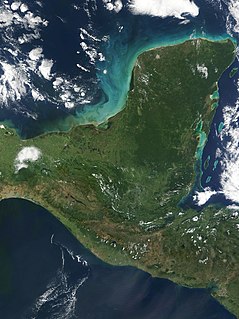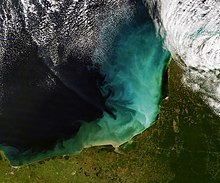Yucatán Peninsula
This article needs additional citations for verification. (February 2016) |
 Satellite image of the Yucatán Peninsula | |
 | |
| Geography | |
|---|---|
| Location | North America |
| Coordinates | 19°33′04″N 89°17′47″W / 19.55111°N 89.29639°W |
| Adjacent to |
|
The Yucatán Peninsula (/ˌjuːkəˈtɑːn/,[1] also UK: /ˌjʊk-/,[2] US: /-ˈtæn, ˌjuːkɑːˈtɑːn/;[1][3][4] Spanish: Península de Yucatán pronounced [ɟʝukaˈtan]) is a large peninsula in southeast Mexico and adjacent portions of Belize and Guatemala. The peninsula extends towards the northeast, separating the Gulf of Mexico to the north and west of the peninsula from the Caribbean Sea to the east. The Yucatán Channel, between the northeastern corner of the peninsula and Cuba, connects the two bodies of water.
The peninsula is approximately 181,000 km2 (70,000 sq mi) in area. It has low relief and is almost entirely composed of porous limestone.[5][6]
The peninsula lies east of the Isthmus of Tehuantepec, the narrowest point in Mexico separating the Atlantic Ocean, including the Gulf of Mexico and Caribbean Sea, from the Pacific Ocean. Some consider the isthmus to be the geographic boundary between Central America and the rest of North America, placing the peninsula in Central America.[5] Politically all of Mexico, including the Yucatán, is generally considered part of North America, while Guatemala and Belize are considered part of Central America.
Etymology
The proper derivation of the word Yucatán is widely debated. 17th century Franciscan historian
History

Pre-human
The Yucatán Peninsula is the site of the Chicxulub crater impact, which was created 66 million years ago[15] by an asteroid of about 10 to 15 kilometers (6 to 9 miles) in diameter at the end of the Cretaceous Period.[16]
Prehistory
In 2020, an underwater archaeological expedition led by Jerónimo Avilés excavated Chan Hol cave, near the Tulum archaeological site in the state of Quintana Roo on the peninsula, and revealed the skeleton of a woman approximately 30 years of age who lived at least 9,900 years ago. According to craniometric measurements, the skull is believed to conform to the mesocephalic pattern, like the other three skulls found in Tulum caves. Three different scars on the skull of the woman showed that she was hit with something hard and her skull bones were broken. Her skull also had crater-like deformations and tissue deformities that appeared to be caused by a bacterial relative of syphilis.[17]
According to study lead researcher Wolfgang Stinnesbeck, "It really looks as if this woman had a very hard time and an extremely unhappy end of her life. Obviously, this is speculative, but given the traumas and the pathological deformations on her skull, it appears a likely scenario that she may have been expelled from her group and was killed in the cave, or was left in the cave to die there”.[citation needed]
The newly discovered skeleton was 140 meters away from the Chan Hol 2 site. Although archaeologists assumed the divers had found the remains of the missing Chan Hol 2, the analysis soon proved that these assumptions were erroneous. Stinnesbeck compared the new bones to old photographs of Chan Hol 2 and showed that the two skeletons represent different individuals.[18]
Due to their distinctive features, study co-researcher Samuel Rennie suggest the existence of at least two morphologically diverse groups of people living separately in Mexico during the transition from Pleistocene to Holocene.[19]
Maya
The Yucatán Peninsula constitutes a significant proportion of the ancient Maya lowlands and was the central location of the Maya Civilization. The Maya culture also extended south of the Yucatán Peninsula into Guatemala, Honduras, and the highlands of Chiapas.[6] There are many Maya archaeological sites throughout the peninsula; some of the better-known are Chichen Itza, Coba, Tulum, and Uxmal.[20] Indigenous Maya and Mestizos of partial Maya descent make up a sizable portion of the region's population, and Mayan languages are widely spoken there.
Spanish conquest
Geology


The peninsula is the exposed portion of the larger
According to the
The
Climate
The peninsula has a tropical climate, which ranges from semi-arid in the northwest to humid in the south. Average annual rainfall ranges from less than 800 mm (30 inches) in the driest parts of the northwest up to 2,000 mm (80 inches) in the Petén Basin to the south. Rainfall varies seasonally, with August and September generally the wettest months.[24]
Like much of the Caribbean, the peninsula lies within the Atlantic Hurricane Belt, and with its almost uniformly flat terrain it is vulnerable to these large storms coming from the east, and the area has been devastated by many hurricanes, such as Hurricane Gilbert, Hurricane Emily, Hurricane Wilma, and Hurricane Dean
Strong storms called nortes can quickly descend on the Yucatán Peninsula any time of year. Although these storms pummel the area with heavy rains and high winds, they tend to be short-lived, clearing after about an hour. The average percentage of days with rain per month ranges from a monthly low of 7% in April to a high of 25% in October. Breezes can have a cooling effect, humidity is generally high, particularly in the remaining rainforest areas.[25]
Water resources
Due to the extreme
Ecology
The vegetation and plant communities of the peninsula vary from north to south. The
Northern Guatemala (
Mangroves occur along the coast, with the Usumacinta mangroves around the Laguna de Términos in the southwest, the Petenes mangroves along the west coast, Ría Lagartos mangroves along the northern shore of the peninsula, and the Mayan Corridor mangroves and Belizean Coast mangroves to the east along the Caribbean Sea.[27]
The
Governance
The peninsula comprises the Mexican states of Yucatán, Campeche, and Quintana Roo, as well as Guatemala's Petén Department and almost all of Belize.[29]
Economy

In the late historic and early modern eras, the Yucatán Peninsula was largely a cattle ranching, logging,
.Population
Population throughout the Yucatán Peninsula is very different throughout each part of the Peninsula. Population density and ethnic composition are two factors that play into the total population. The most populated area is Mérida in Yucatán state and the surrounding region, contrasted by the state of Quintana Roo, the least populated part of the peninsula. In terms of ethnic composition, a majority of the population consisted of both Maya and Mestizos.[30]
See also
Footnotes
- ^ For discussion of the different interpretations of this somewhat mythic encounter, see Castañeda 2002
- ^ a b "Yucatán". Collins English Dictionary. HarperCollins. Retrieved 26 July 2019.
- ^ "Yucatán". Lexico UK English Dictionary. Oxford University Press.[dead link]
- ^ "Yucatán". The American Heritage Dictionary of the English Language (5th ed.). HarperCollins. Retrieved 26 July 2019.
- ^ "Yucatán". Merriam-Webster.com Dictionary. Retrieved 26 July 2019.
- ^ ISBN 0816057869.
- ^ ISBN 0-89577-087-3.
- ^ ISBN 9783643904812. Retrieved 9 February 2020.
- S2CID 161263168.
- ^ ISBN 9781943066049. Retrieved 9 February 2020.
- ISBN 9781316873670. Retrieved 9 February 2020.
- ^ Cartas y relaciones de Hernan Cortés al emperador Carlos V (in Spanish). Paris: A. Chaix y ca. 1866. p. 1 footnote 2. Retrieved 13 December 2010.
- ^ "Ibero-American Electronic Text Series: Primera Carta de Relación, PREÁMBULO" (in Spanish). Board of Regents of the University of Wisconsin System. 1945. Retrieved 13 December 2010.
- ^ a b c d Hajovsky, Ric (2011). "How Yucatan got its name". Everything Cozumel. Retrieved 3 February 2020.
- ISBN 9781349125739. Retrieved 9 February 2020.
- ^ a b c d Osterloff, Emily (2018). "How an asteroid ended the age of the dinosaurs". London: Natural History Museum. Archived from the original on 26 April 2022. Retrieved 18 May 2022.
- S2CID 6112274.
- PMID 32023279.
- ^ PLOS (5 February 2020). "9,900-Year-Old Skeleton Discovered in Submerged Mexican Cave Has a Distinctive Skull". SciTechDaily. Retrieved 19 March 2020.
- ^ Geggel, Laura (5 February 2020). "9,900-year-old skeleton of horribly disfigured woman found in Mexican cave". livescience.com. Retrieved 19 March 2020.
- ^ "Yucatan Peninsula Archaeological Map | 27 Ancient Maya Sites". mayaruins.com.
- ^ Yarris, Lynn (9 March 2010). "Alvarez Theory on Dinosaur Die-Out Upheld: Experts Find Asteroid Guilty of Killing the Dinosaurs". News Center. Retrieved 8 December 2020.
- ^ "Chicxulub Crater and Ring of Cenotes". Karst Geochemistry and Hydrogeology. 4 April 2018. Retrieved 8 December 2020.
- ^ "Arrowsmith Bank, Undersea Features - Geographical Names, map, geographic coordinates". geographic.org.
- ISBN 978-3-319-06529-8.
- ^ http://www.kwintessential.co.uk/articles/mexico/Yucatan-Weather-Climate/704 [dead link]
- ^ BBC: Planet Earth, part 4: Caves.
- ^ doi:10.1641/0006-3568(2001)051[0933:TEOTWA]2.0.CO;2.)
{{cite journal}}: CS1 maint: multiple names: authors list (link - JSTOR 982931.
- ^ "Yucatán Peninsula". Encyclopaedia Britannica. Retrieved 7 August 2018.
- ^ a b "Yucatán Peninsula | peninsula, Central America". Encyclopedia Britannica. Retrieved 10 December 2020.
- Juan Luis Pena Chapa, Manuel Martin Castillo, and Juan Carlos Gonzalez Avila, The Performance of the Economy of the Yucatan Peninsula from 1970–1993 [1]
- Marcio L. Teixeira,The Impact of the Geologic History of the Yucatán Peninsula on the Present Day Aquifer,2004 [2]
- Angelo Heilprin,Observations on the Flora of Northern Yucatan [3]
External links
 Media related to Yucatán Peninsula at Wikimedia Commons
Media related to Yucatán Peninsula at Wikimedia Commons Yucatán Peninsula travel guide from Wikivoyage
Yucatán Peninsula travel guide from Wikivoyage
